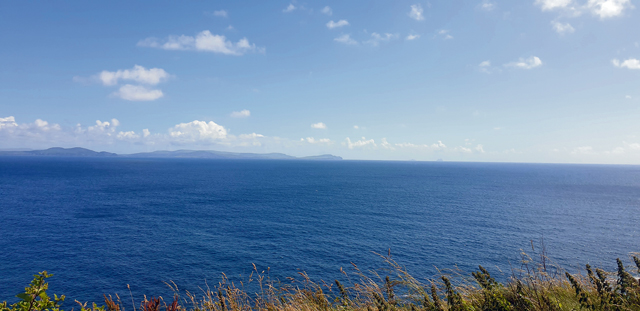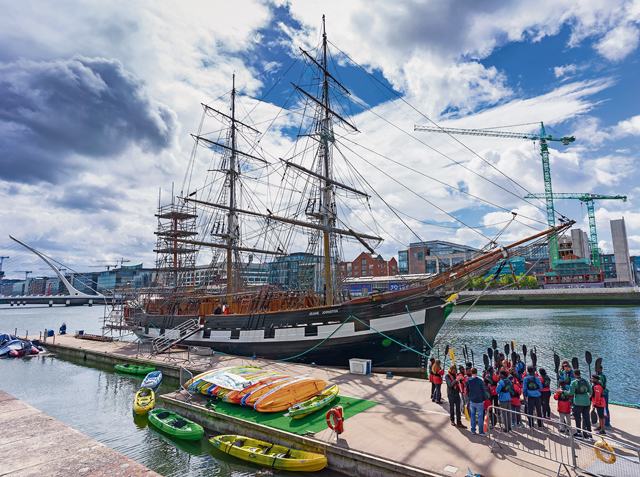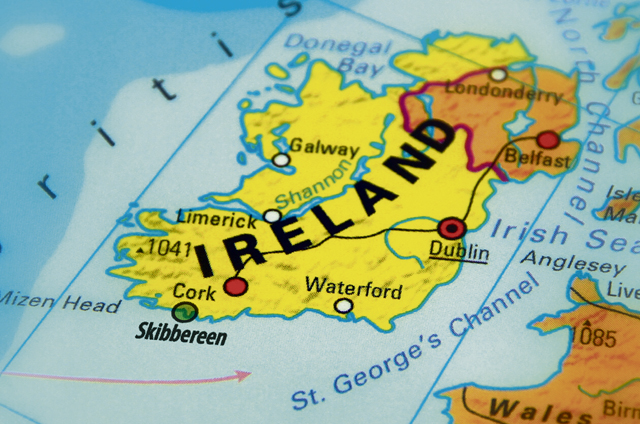
America from this point.
According to a 2020 census, 191 million Americans — making up 57 percent of the population — have European roots. After Germans, the second largest group is said to be descendants of Irish immigrants, which make up 11 percent of the population of the United States.
In the mid 1840’s the population of Ireland was about 8.5 million inhabitants, with a large part of them living in rural areas as farmers who mainly cultivated potatoes. In the early 1840’s a blight infected potato crops leading to bad harvests throughout Europe. The blight is a fungus which infects the leaves and stem, turning the potato into a mass of pulp. This not only led to starvation and disease in Ireland itself, but also caused social unrest and about 100,000 deaths throughout the mainland of Europe as well.
The most severely affected areas in Ireland were in the West and South, where the Irish, or Gaelic, language was dominant. The period became known as a Drochshaol, translated as a bad life in Gaelic. Overall, the effects lasted up until 1855 and is today referred to as the Great Hunger, the Irish Famine or just the Famine.
During this period about one million people died of starvation or diseases that came along with malnutrition. The worst year was 1847, which became known as Black 47 and caused the population to decrease by 25 or more percent, in some areas up to 67 percent. In addition to the populace facing hunger, this also led to an increase of petty crime. Theft of a loaf of bread could lead to imprisonment, mainly in England due to Ireland being under English occupation.

Prisons in England were overflowing and since the crown was in the process of colonizing Australia, a person could easily find themselves being deported to Sydney. It is confirmed more than 40,000 convicts were sent to Australia, often sentenced to working on farms for seven years. Some Irishmen may have returned, but many just stayed and this accounts for the high number of Irish descendants in Australia. More than two million people, 9.5 percent of the Australian population, reported Irish ancestry in a 2021 census.
Between 1845 and 1855, at least one million people left Ireland via packet ships, steamboats and barques. The era is noted as one of the greatest exoduses from an island in history. Some emigrants were so poor they literally offered their last shirt for passage to the United States or Canada and boarded famine ships, often referred to as coffin ships. The vessels were in an unseaworthy state, had a lack of clean drinking water, poor sanitary conditions and enforced the spread of disease. It is noted between 20 to 50 percent of passengers died during or shortly after their perilous 3,000-mile voyage. A female humanitarian organization in New York was highly alarmed but determined to help. They welcomed the ships with clothes, blankets and care packages of food and necessities upon arrival.
In addition, many tenants were evicted from their lots by their English landlords as they could no longer pay their annual dues, usually in the form of potatoes or other vegetables. Their last resort was to move into a workhouse or offer hard labor for food working on schemes, such as heavy construction projects building roads. Some were forced to pawn their clothes and ended up freezing in a lack of appropriate clothing or died of mere exhaustion. By 1847, a workhouse in Skibbereen was so overcrowded that one person was allotted two square feet to live and sleep on, while others passed away on the streets and often enough had to be buried in mass graves.
There were also a few initiatives in Ireland to alleviate the situation by opening soup kitchens throughout the nation. One of the many was in Skibbereen. Skibbereen is located in the Southwestern part of Ireland, which was one of the most poverty stricken and impacted counties. The city operates a heritage center with an exclusive display dedicated to the Famine Story and a genealogical section where staff members can assist in tracing your roots. It also displays an original recipe for a soup, where many a starving soul received one bowl of the broth per day.
See https://skibbheritage.com for further information

On a more positive note, there were also humanists who made instrumental efforts in supporting the Irish during this devastating time. The Jeanie Johnston was a three-mast barque, built in 1847 in Quebec, Canada, and was originally intended as a cargo ship. It quickly switched its purpose to transport people and provide relief from the famine instead. She made her maiden voyage from Blennerville in Tralee, County Kerry, with 193 passengers on her voyage to Canada in 1848. Humanitarian captain James Attridge joined the ship and made 16 transatlantic voyages between 1848 and 1855. During these voyages, Attridge moved 2,500 passengers, without a single loss, and returned to Ireland with timber on board.
A remake of the historic ship can be visited and its history explored in Dublin. The ship is docked on the River Liffey alongside the Famine Memorial on Customs House Quay in remembrance of the country halved through death and emigration.
As word spread around the world, many countries offered monetary donations and Native Americans in the United States sent shiploads of corn to the island. Additionally, the Choctaw tribe raised $170, equal to $6,200 today, in an effort to help the starving Irish. A sculpture in the form of feathers is located in Cork, Ireland, to commemorate this act of kindness.
Irish immigrants were not always warmly welcomed. Many found themselves in gloomy ghettos or poor slums of large cities such as New York, Chicago, Boston and Philadelphia, which also served as immigration ports. Most Irish immigrants pulled through, working jobs such as constructions, garbage removal staff, as factory workers or entertained passersby with traditional music.
Some ventured on and founded cities such as Dublin, Georgia, and Butte, Montana, where 25 percent of inhabitants claim to have Irish ancestry. Irish people were instrumental in helping to build and develop large cities with muscle power, perseverance and their well-known sense of humor. Following generations managed to create a strong foundation in society and eventually prosper, while some families came to wealth and engaged in political life.
One widely known family is the Fitzgeralds, originally from County Limerick, who immigrated during the Great Famine between 1846 and 1855. Some married members of the Kennedy clan, another group of Irish immigrants and their descendants. Their most famous character was President John F. Kennedy, who was proud of his lineage and stated the following during his trip to Ireland in 1963.
“When my great grandfather left here to become a cooper in East Boston, he carried nothing with him except two things: a strong religious faith and a strong desire for liberty,” said Kennedy. “I am glad to say that all of his great-grandchildren have valued that inheritance.”
The Irish not only brought their faith and optimistic mindset to the United States, but also music that shaped history. Some country music rhythms find their origins in traditional Irish tunes with fiddles and drums. The largest Irish festival, known as St. Patrick’s Day, is dedicated to Patrick, who was instrumental in Christianizing the island in the fifth century. Every year, the Chicago River turns green March 17 and gives occasion for large parades and bustling parties in green.
Another tradition brought by the Irish is Halloween, originally adapted from the Celtic celebration of Samhain and observed on the eve of All Saints Days on October 31. Whiskey brought from Ireland and Scotland served as forerunners of modern distilleries today, not to forget Irish stew or Guinness beer.
A number of other prominent characters have Irish roots, such as George Clooney, Barack Obama and Mariah Carey. And, last but not least, over 800 email addresses on the Air Force global system begin with the prefix “Mc”, such as McFarland and McIlrath, in addition to a number of O’Connell, O’Brian, Kennedy and Murphy.
If you feel that you have Irish or even partially Irish roots, use your time while stationed in the in the Kaiserslautern Military Community to visit the enchanting emerald isle. It’s only a hop and skip away and holds a world full of history, stories to tell and many opportunities to trace your roots. Make discoveries on the rolling hills with a thousand shades of green which gave the island its name, or dream of Celtic times along the Wild Atlantic Way. Meet the wonderful and helpful people, experience their special humor, and with the luck of the Irish, you may even encounter a leprechaun on the way. Fáilte go Éirinn.
Special thanks to the Skibbereen Heritage Centre with Terri Kearney and her team for special insight to the Famine Story. Anyone interested in in-depth information, can study her book or indulge in the “Famine Diary” by Gerard Keegan based on a true account of an emigrant around 1847.
Soyer’s Soup recipe
- One quarter leg of beef
- 2 gallons of water
- 3 ounces of drippings
- 2 pounds of flour
- Half pound of pearl barley
- 3 ounces of salt
- Half pound of brown sugar
(Created by Alex Soyer, a French chef of the Reform Club in London)


